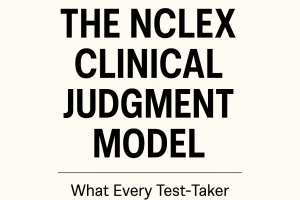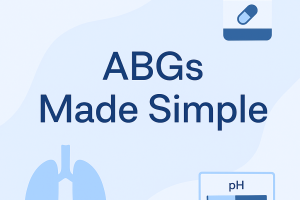CARING FOR PEDIATRIC PATIENTS WITH RESPIRATORY DISORDERS: NCLEX MUST-KNOW INTERVENTIONS.

Introduction
Caring for children with respiratory disorders presents unique challenges for nurses. Pediatric patients are particularly vulnerable due to their developing respiratory systems and smaller airways. Effective nursing interventions are crucial to ensure optimal outcomes. This guide delves into essential interventions for common pediatric respiratory conditions, aligning with NCLEX standards.
1. Asthma Management
Asthma is a prevalent chronic respiratory condition in children, characterized by airway inflammation and bronchoconstriction.
• Assessment: Monitor for signs such as wheezing, coughing, shortness of breath, and chest tightness. Utilize peak flow meters to assess airway obstruction levels.
• Interventions:
• Administer bronchodilators (e.g., albuterol) and anti-inflammatory medications as prescribed.
• Educate patients and families on proper inhaler techniques to ensure effective medication delivery.
• Develop an asthma action plan, detailing daily management and steps during exacerbations.
• Identify and minimize exposure to known triggers, such as allergens or environmental irritants.
2. Bronchiolitis Care
Bronchiolitis, often caused by the respiratory syncytial virus (RSV), affects infants and young children, leading to inflammation of the bronchioles.
• Assessment: Observe for symptoms like nasal congestion, cough, wheezing, and difficulty breathing. Monitor oxygen saturation levels to detect hypoxemia.
• Interventions:
• Provide supportive care, including hydration and maintaining clear airways through suctioning.
• Administer supplemental oxygen for patients with low oxygen saturation.
• Implement isolation protocols to prevent the spread of RSV within healthcare settings.
• Educate caregivers on signs of respiratory distress and when to seek medical attention.
3. Cystic Fibrosis Management
Cystic fibrosis is a genetic disorder resulting in thick, sticky mucus production, affecting the lungs and other organs.
• Assessment: Monitor respiratory function, noting cough characteristics, sputum production, and lung sounds. Regularly assess nutritional status due to malabsorption issues.
• Interventions:
• Perform chest physiotherapy to aid mucus clearance from the airways.
• Administer prescribed medications, including mucolytics and pancreatic enzymes.
• Encourage a high-calorie, high-protein diet to meet increased metabolic demands.
• Educate families on infection prevention strategies and the importance of routine follow-ups.
4. Epiglottitis Emergency Management
Epiglottitis is a life-threatening condition characterized by inflammation of the epiglottis, leading to airway obstruction.
• Assessment: Rapid onset of symptoms such as high fever, sore throat, drooling, and stridor. Avoid throat examinations that could exacerbate airway obstruction.
• Interventions:
• Ensure emergency airway equipment is readily available.
• Administer humidified oxygen to ease breathing.
• Prepare for possible intubation or tracheostomy if airway compromise occurs.
• Administer intravenous antibiotics as prescribed to treat the underlying infection.
5. General Nursing Considerations
• Family Education: Empower families with knowledge about the child’s condition, treatment plans, and signs of worsening symptoms.
• Emotional Support: Recognize the emotional toll on both the child and family, providing reassurance and psychological support.
• Infection Control: Adhere to strict hand hygiene and isolation protocols to prevent nosocomial infections.
NCLEX-Style Practice Questions
1. A 4-year-old with asthma presents with wheezing and shortness of breath. Which intervention should the nurse implement first?
• A) Administer a corticosteroid inhaler.
• B) Provide a bronchodilator via nebulizer.
• C) Encourage pursed-lip breathing.
• D) Obtain a peak flow reading.
Answer: B) Provide a bronchodilator via nebulizer.
Rationale: Administering a bronchodilator helps to quickly relieve bronchoconstriction, improving airflow.
2. An infant diagnosed with bronchiolitis is admitted to the pediatric unit. Which nursing intervention is the priority?
• A) Initiate intravenous fluids.
• B) Suction nasal secretions to maintain airway patency.
• C) Administer antibiotics as prescribed.
• D) Place the infant in a prone position.
Answer: B) Suction nasal secretions to maintain airway patency.
Rationale: Clearing nasal secretions is essential to ensure the infant can breathe effectively, as they are obligate nose breathers.
3. Parents of a child with cystic fibrosis ask about ways to help their child clear mucus. Which recommendation should the nurse provide?
• A) Engage in regular aerobic exercise.
• B) Limit fluid intake before bedtime.
• C) Use a cool-mist humidifier in the child’s room.
• D) Administer cough suppressants as needed.
Answer: A) Engage in regular aerobic exercise.
Rationale: Physical activity can enhance mucus clearance and improve overall lung function in children with cystic fibrosis.
4. A child is suspected of having epiglottitis. Which action should the nurse avoid?
• A) Inspecting the child’s throat with a tongue depressor.
• B) Keeping the child in an upright position.
• C) Providing humidified oxygen.
• D) Preparing for emergency airway management.
Answer: A) Inspecting the child’s throat with a tongue depressor.
Rationale: Inspecting the throat can trigger a complete airway obstruction in a child with epiglottitis and should be avoided.
Conclusion
Nurses play a pivotal role in managing pediatric respiratory disorders. Through comprehensive assessment, timely interventions, and family education, nurses can significantly improve outcomes for these young patients. Staying informed about best practices and maintaining a compassionate approach are essential components of effective pediatric respiratory care.






